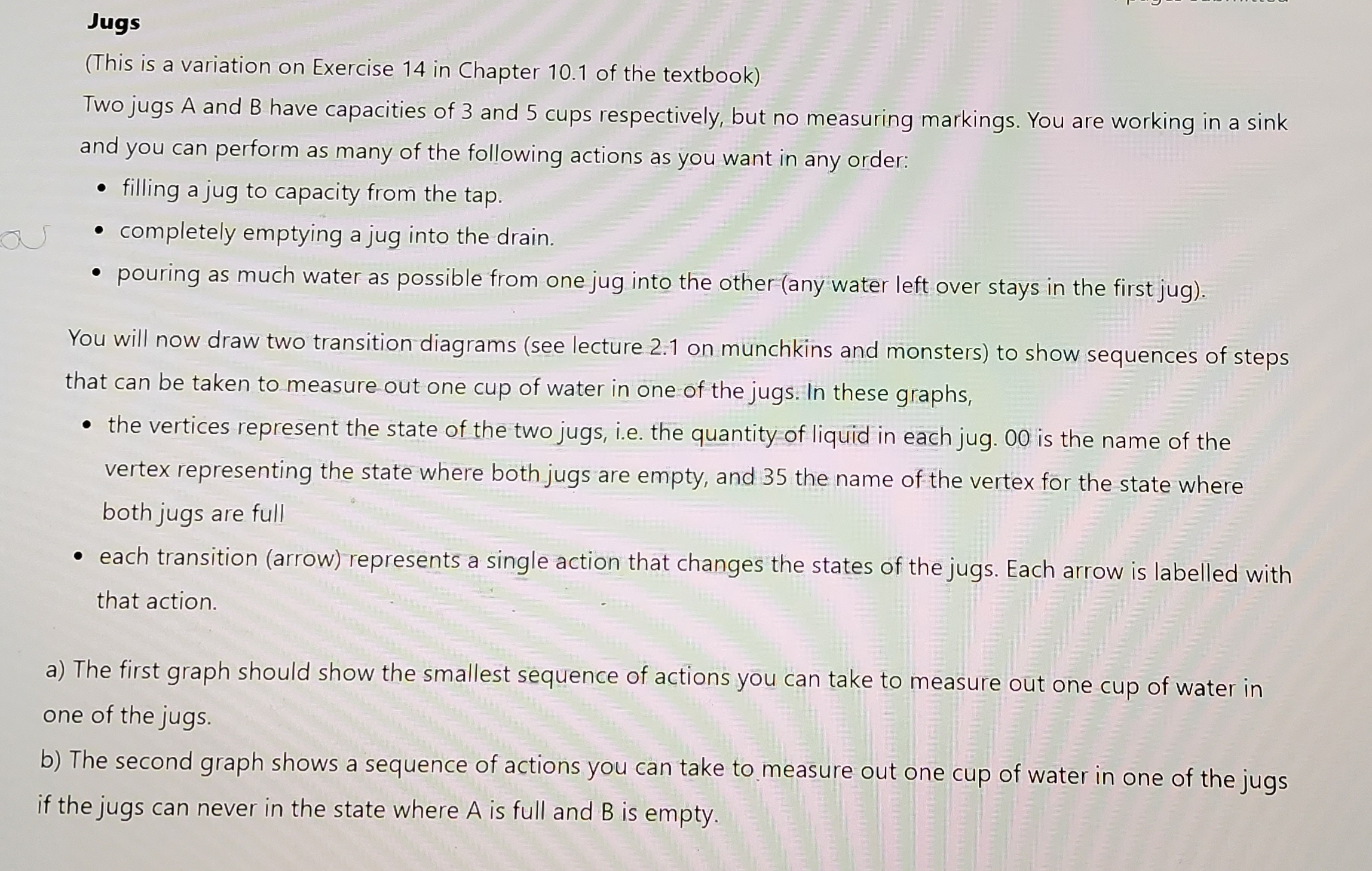
Computer Networking: A Top-Down Approach (7th Edition)
7th Edition
ISBN: 9780133594140
Author: James Kurose, Keith Ross
Publisher: PEARSON
expand_more
expand_more
format_list_bulleted
Question
Can u solve this ?

Transcribed Image Text:Jugs
(This is a variation on Exercise 14 in Chapter 10.1 of the textbook)
Two jugs A and B have capacities of 3 and 5 cups respectively, but no measuring markings. You are working in a sink
and you can perform as many of the following actions as you want in any order:
filling a jug to capacity from the tap.
completely emptying a jug into the drain.
pouring as much water as possible from one jug into the other (any water left over stays in the first jug).
You will now draw two transition diagrams (see lecture 2.1 on munchkins and monsters) to show sequences of steps
that can be taken to measure out one cup of water in one of the jugs. In these graphs,
• the vertices represent the state of the two jugs, i.e. the quantity of liquid in each jug. 00 is the name of the
vertex representing the state where both jugs are empty, and 35 the name of the vertex for the state where
both jugs are full
• each transition (arrow) represents a single action that changes the states of the jugs. Each arrow is labelled with
that action.
a) The first graph should show the smallest sequence of actions you can take to measure out one cup of water in
one of the jugs.
b) The second graph shows a sequence of actions you can take to measure out one cup of water in one of the jugs
if the jugs can never in the state where A is full and B is empty.
Expert Solution
This question has been solved!
Explore an expertly crafted, step-by-step solution for a thorough understanding of key concepts.
Step by stepSolved in 3 steps

Knowledge Booster
Similar questions
- 3 TRUE or FALSE DO NOT COPY FROM OTHER WEBSITES Upvote guarenteed for a correct and detailed answer. Thank you!!!arrow_forwardhi plz i need help i will rate u discrete mathematics please if u can answer the both questionsarrow_forwardThe following is one big question, please answer the followingarrow_forward
- Question 5 Please answer them correctly by choosing one of the following answerarrow_forwardq6) Which of the following asymptotic notation is used for representing the lower bound of an algorithm with respective space and time complexity? a. Big Alpha (α) b. Big Oh(O) c. Big Omega (Ω) d. Big Theta (Θ)arrow_forwardLet the universe of discourse be the set of positive integers. By selecting True or False, give the truth value of the following: ThereExistsUnique x (x = 2x + 1). True ○ Falsearrow_forward
- ATTEMPT ONLY IF YOU ARE 100% SURE DO NOT COPY FROM OTHER WEBSITESarrow_forwardWhat is the difference between Transform and Conquer & Divide and Conquer? Justify your answer by providing at one example for each algorithm in solving a problem.arrow_forwardcomputes and returns the smallest positive integer n for which 1+2+3+...+n equals or exceeds the value of "goal".arrow_forward
arrow_back_ios
arrow_forward_ios
Recommended textbooks for you
 Computer Networking: A Top-Down Approach (7th Edi...Computer EngineeringISBN:9780133594140Author:James Kurose, Keith RossPublisher:PEARSON
Computer Networking: A Top-Down Approach (7th Edi...Computer EngineeringISBN:9780133594140Author:James Kurose, Keith RossPublisher:PEARSON Computer Organization and Design MIPS Edition, Fi...Computer EngineeringISBN:9780124077263Author:David A. Patterson, John L. HennessyPublisher:Elsevier Science
Computer Organization and Design MIPS Edition, Fi...Computer EngineeringISBN:9780124077263Author:David A. Patterson, John L. HennessyPublisher:Elsevier Science Network+ Guide to Networks (MindTap Course List)Computer EngineeringISBN:9781337569330Author:Jill West, Tamara Dean, Jean AndrewsPublisher:Cengage Learning
Network+ Guide to Networks (MindTap Course List)Computer EngineeringISBN:9781337569330Author:Jill West, Tamara Dean, Jean AndrewsPublisher:Cengage Learning Concepts of Database ManagementComputer EngineeringISBN:9781337093422Author:Joy L. Starks, Philip J. Pratt, Mary Z. LastPublisher:Cengage Learning
Concepts of Database ManagementComputer EngineeringISBN:9781337093422Author:Joy L. Starks, Philip J. Pratt, Mary Z. LastPublisher:Cengage Learning Prelude to ProgrammingComputer EngineeringISBN:9780133750423Author:VENIT, StewartPublisher:Pearson Education
Prelude to ProgrammingComputer EngineeringISBN:9780133750423Author:VENIT, StewartPublisher:Pearson Education Sc Business Data Communications and Networking, T...Computer EngineeringISBN:9781119368830Author:FITZGERALDPublisher:WILEY
Sc Business Data Communications and Networking, T...Computer EngineeringISBN:9781119368830Author:FITZGERALDPublisher:WILEY

Computer Networking: A Top-Down Approach (7th Edi...
Computer Engineering
ISBN:9780133594140
Author:James Kurose, Keith Ross
Publisher:PEARSON

Computer Organization and Design MIPS Edition, Fi...
Computer Engineering
ISBN:9780124077263
Author:David A. Patterson, John L. Hennessy
Publisher:Elsevier Science

Network+ Guide to Networks (MindTap Course List)
Computer Engineering
ISBN:9781337569330
Author:Jill West, Tamara Dean, Jean Andrews
Publisher:Cengage Learning

Concepts of Database Management
Computer Engineering
ISBN:9781337093422
Author:Joy L. Starks, Philip J. Pratt, Mary Z. Last
Publisher:Cengage Learning

Prelude to Programming
Computer Engineering
ISBN:9780133750423
Author:VENIT, Stewart
Publisher:Pearson Education

Sc Business Data Communications and Networking, T...
Computer Engineering
ISBN:9781119368830
Author:FITZGERALD
Publisher:WILEY